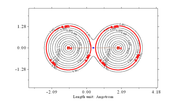Multiwfn forum
Multiwfn official website: http://sobereva.com/multiwfn. Multiwfn forum in Chinese: http://bbs.keinsci.com/wfn
You are not logged in.
- Topics: Active | Unanswered
Pages: 1
#1 Re: Multiwfn and wavefunction analysis » No bond critical points found between N anH in aminobenzenes » 2025-02-13 18:47:24
Fixed! Many thanks. ![]()
#2 Multiwfn and wavefunction analysis » No bond critical points found between N anH in aminobenzenes » 2025-02-13 12:22:58
- Antuán
- Replies: 2
Dear Tian Lu,
when I try to make a topologic analysis over different substituted benzenes with amino groups (-NH2), the bond criticaL points between N and H don't appear (not calculated). Even, if I use the option to find new critical points from the nitrogen atom, no new CPs are found. What to do?
#3 Re: Multiwfn and wavefunction analysis » Problem with suffix 'a' in contour lines » 2021-08-24 14:15:41
I understand ... ![]()
Thank u for the kind explanation.
Regards
#4 Multiwfn and wavefunction analysis » Problem with suffix 'a' in contour lines » 2021-08-23 15:12:20
- Antuán
- Replies: 2
Hi again.
Making the contour lines I have encountered a bug for the using of suffix 'a' in order to indicate Angstrom instead of Bohr. Here you are the sequence used after the corresponding topological analysis from the main menu:
4/1/2/grid selection/1(xy plane)/for z I used 0.0a and the units of the generated graph are always Bohr instead of Angstrom. Doesn't matter because you can use option -8 that works correctly, but this problem seems not to appear for the other plane directions. Just a little detail. Thanks again!
#5 Re: Multiwfn and wavefunction analysis » Contour line numbers beyond 0.001 (VdW limit) » 2021-08-23 14:53:38
Thank you very much, although it will be very useful to have the default values (three decimals is quite OK), and a 'custom' value which could appear as the input indicated by the user, for example. Maybe ... Think about ![]()
#6 Multiwfn and wavefunction analysis » Contour line numbers beyond 0.001 (VdW limit) » 2021-08-23 10:29:35
- Antuán
- Replies: 3
Dear Tian Lu,
making a grafh representing the isodensity values around the He dimer, the BCP point is just beyond the VdW limit (0.001 electrons). So, I have manually added a new contour line with a isodensity value of 0.0005. However, the number appearing in the graph seems to be rounded to three decimal places, appearing again 0.001. I'm sending you the image to see the problem. Thanks again for all your effort.
#7 Re: Multiwfn and wavefunction analysis » About quickCBS » 2020-12-16 11:25:28
OK. Have a nice day!!
#8 Re: Multiwfn and wavefunction analysis » About quickCBS » 2020-12-15 23:26:30
Many thanks Tian. And the last question, do quickCBS calculate the error of the CBS estimation?
#9 Re: Multiwfn and wavefunction analysis » About quickCBS » 2020-12-15 22:03:04
Many thanks!!! And do you will have soon support for ORCA outputs?
#10 Multiwfn and wavefunction analysis » About quickCBS » 2020-12-15 21:48:50
- Antuán
- Replies: 6
Dear Tian,
you have a kindly way to get the CBS limit from CCSD(T) single point calculations, but you don't talk about the starting geometry you need for this task. Do you have a preferred choice?
Thanks in advance,
Antonio
#11 Re: Multiwfn and wavefunction analysis » Evaluating H-bond energies and ELF-¿sigma? » 2020-11-20 20:05:20
Hello again,
Many thanks for your quick response. Take also account the table of contents in order to change the sigma-alpha reference.
Keep up the good work.
Best regards,
Antonio
#12 Multiwfn and wavefunction analysis » Evaluating H-bond energies and ELF-¿sigma? » 2020-11-19 12:55:55
- Antuán
- Replies: 2
Hi Tian,
first of all, congratulations for the awsome program you are developing and supporting. Thanks. I've seen in the page 359 that you have got a new way to calculate the energy involved in an H-bond. You propose the ??≈−223.08×?(?BCP)+0.7423(for neutral H−bond) formulae, giving in your example 6.2 kcal/mol for this interaction. Well, you compare this value with that obtained from reference Chem. Phys. Lett., 285, 170(1998) in which this energy is evaluated from the potential energy density at the BCP as BE=V(?BCP)/2, arising 8.2 kcal/mol. I agree, this approach probably overestimates the 'real' value. Nevertheless, you omitted another approach reflected in Chem. Phys. Lett., 507, 185(2011), in which BE is evaluated as 0.429×G(?BCP), that is 6.8 kcal/mol, which actually corresponds with a close value to yours.
Second stuff. In pages 412-415 the ELF-sigma appears as ELF-alpha, and talk about alpha orbitals instead of sigma ones. Maybe you have a reason for this although the general decomposition of the ELF function is sigma and pi, isn't it?
Thanks again and good luck! You have done a very good job.
Best regards.
Antonio
Pages: 1